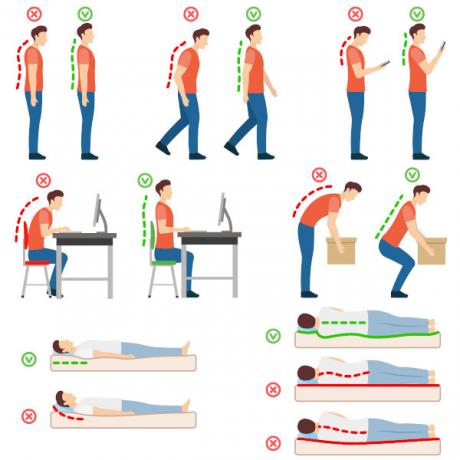good posture it mainly refers to the alignment of our body so that our bones, muscles and joints are able to guarantee our support and movement without being negatively affected. When we sit incorrectly, for example, we can trigger, over time, changes in our spine that can cause pain and even muscle shortening. When sitting down, bending down to pick something up, walking or even preparing to sleep, it is essential that we pay attention to our posture.
Read too: What is pain, what is its purpose and what are its types?
Importance of having good body posture

Many people think that good posture is only related to aesthetics, however, it is essential for the health of our body. good posture ensures that our entire body works properly, since it allows our muscles, bones and joints to be completely aligned and its functioning can occur without any hindrance. In the long run, poor posture can trigger problems such as:
- Back pains;
- Neck pains;
- Headaches;
- Wear on joints;
- Bone changes;
- Deviations in the spine (hyperlordosis, hyperkyphosis and scoliosis).
Column deviations
Over the years, poor posture can be responsible for triggering deviations in our spine. As we know, the spine works as the central axis of our body, being also responsible for ensuring the protection of our spinal cord. Changes in this central axis can be quite harmful, causing, for example, back pain, neck pain, difficulty holding weight, difficulty moving and tingling.
Learn about the main postural deviations below:
- Hyperkyphosis: it is an increase in curvature in the thoracic region, giving the appearance of a hump. A person with hyperkyphosis has their back arched and their shoulders projected forward.
- Hyperlordosis: it is characterized by an accentuation of the lumbar curvature. In this case, the person presents with the most prominent glutes.
- Scoliosis: it is a lateral curvature of the spine. Typically, the column of the person with this problem is S-shaped.

Postural deviations will be treated according to the severity of each case, but generally included physiotherapy and Exercises of strengthening of the musculature. In some cases, orthopedic vests may be recommended.
Read more: Spine – an important part of our skeletal system: structure and problems
Tips for good body posture
Taking care of posture is taking care of the health of our body, so we have to be aware, for example, of our movements, how we sit and lie down. In addition, it is essential that we practice physical activities so that our muscles are stronger and that we have greater flexibility, thus ensuring us a better posture. Below, we separate some important points to always have a proper posture:

- When walking, keep your spine straight and look straight ahead.
- When bending down to pick up an object, do not bend your spine. Lower yourself by bending your knees and keeping your back straight.
- Do not carry backpacks or bags on one side of your body. In the case of backpacks, it is essential to use both straps. In the case of bags, distribute the weights between both hands.
- As you sit, snug your hips into the seat of the chair and lean your back against the backrest. Always keep your torso straight and your neck aligned.
- When using your computer, make sure the monitor is in front of you and the top of the screen is at eye level.
- When using the cell phone, avoid tilting your head down. Ideally, bring the device up to eye level.
- A highly recommended way to get a good night's sleep is to lie down on your side using a pillow that adequately fills the space between your head and the end of your shoulder. A pillow between your knees ensures your spine stays straight overnight.

